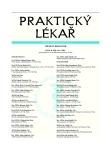Current opinion on urogenital tuberculosis
Authors:
R. Zachoval; P. Nencka; V. Vik; V. Borovička; P. Holý
Authors‘ workplace:
Urologické oddělení
; Primář: doc. MUDr. Roman Zachoval, PhD
; Fakultní Thomayerova nemocnice, Praha
Published in:
Prakt. Lék. 2010; 90(12): 700-703
Category:
Reviews
Overview
Urogenital tuberculosis is a relatively rare form of tuberculosis. Symptoms are non-specific and the latency between primary infection and onset of disease is long; therefore diagnosis and timely therapeutic intervention are difficult. Urogenital tuberculosis should be considered when urological symptoms are prolonged and the diagnosis is unclear.
Diagnosis consists mainly of 5 consecutive urine cultures, molecular methods, imaging methods and examination of histological specimens. Antituberculous drugs are usually the primary treatment.
Surgical treatment comes after at least 4 weeks of antituberculous drug treatment with the exception of abscess drainage or diversion of hydronephrosis, which leads to a decreased incidence of ureteral strictures and renal function deterioration.
Key words:
tuberculosis urogenital, diagnosis, antituberculous drugs.
Sources
1. Čermák, P., Havelková, M. Laboratory diagnosis of mycobacterial infections. Klin. Mikrobiol. Infekc. Lek. 2010, 16, 2, s. 36-42.
2. Figueiredo, A.A., Lucon, A.M. Urogenital tuberculosis: update and review of 8961 cases from the world literature. Rev. Urol., 2008, 10(3), p. 207-217.
3. Figueiredo, A.A., Lucon, A.M., Gomes, C.M., Srougi, M. Urogenital tuberculosis: patient classification in seven different groups according to clinical and radiological presentation. Int. Braz. J. Urol., 2008, 34(4), p. 422-432.
4. Figueiredo, A.A., Lucon, A.M., Junior R.F., Srougi, M. Epidemiology of urogenital tuberculosis worldwide. Int. J. Urol., 2008, 15(9), p. 827-832.
5. Homolka, J., Krejbich, F., Holub, J. Tuberculosis in the Czech Republic in the year 2007. Čas. Lék. čes. 2009, 148, 5., s. 197-200.
6. Jacob, J.T., Nguyen, T.M., Ray, S.M. Male genital tuberculosis. Lancet Infect. Dis., 2008, 8(5), p. 335-342.
7. Rui, X., Li, X.D., Cai, S. et al. Ultrasonographic diagnosis and typing of renal tuberculosis. Int. J. Urol., 2008, 15(2), p. 135-139.
8. Svobodová, J., Dujsíková, H., Jedličková, H., Pavlík, I. Mycobacteria at extrapulmonary sites. Klin. Mikrobiol. Infekc. Lek. 2010, 16, 2, s. 43-47.
9. Trnka, L., Wallenfells, J. How to continue in the treatment of tuberculosis in the Czech Republic? Čas. Lek. čes., 2007, 146, 4, s. 351-355.
10. Vašáková, M. Extrapulmonary tuberculosis. Epidemiol. Mikrobiol. Imunol., 1998, 47, 1, s. 23-26.
11. Volkov, A.A., Zuban, O.N. Obstructive uropathy in nephrotuberculosis and the results of its surgical correction. Probl. Tuberk. Bolezn. Legk. 2009, 4, p. 59-62.
12. Winer, A.G., Georges, C., Feliciano, J., Hyacinthe, L. Severe bilateral hydronephrosis and hydroureter secondary to bladder tuberculosis. J. Urol., 2010, 184(5), p. 2138-2139.
13. Wise, G.J. Urinary tuberculosis: modern issues. Curr. Urol. Rep., 2009, 10(4), p. 313-316.
14. Wise, G.J., Shteynshlyuger A. An update on lower urinary tract tuberculosis. Curr. Urol. Rep., 2008, 9(4), p. 305-313.
Labels
General practitioner for children and adolescents General practitioner for adultsArticle was published in
General Practitioner

2010 Issue 12
Most read in this issue
-
Basics of social cognitive and affective neuroscience;
I. Introduction - Regional differentiation of the age structure of practitioners in the Czech Republic at the beginning of the 21st century
- Patient friendly health care for migrants
- Addictive diseases and poverty
